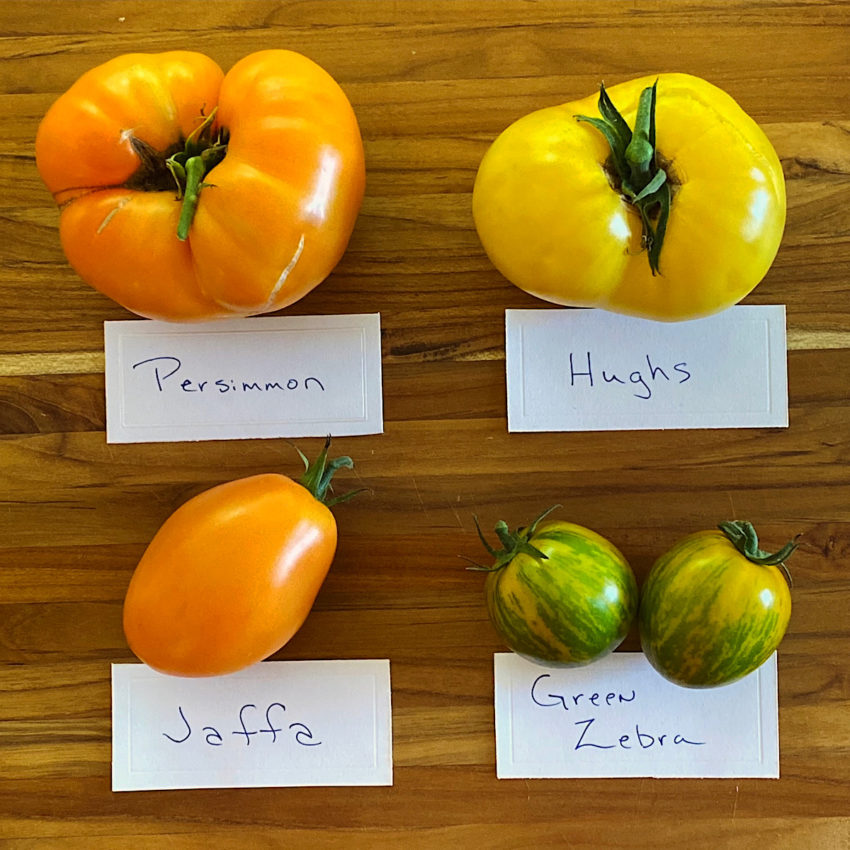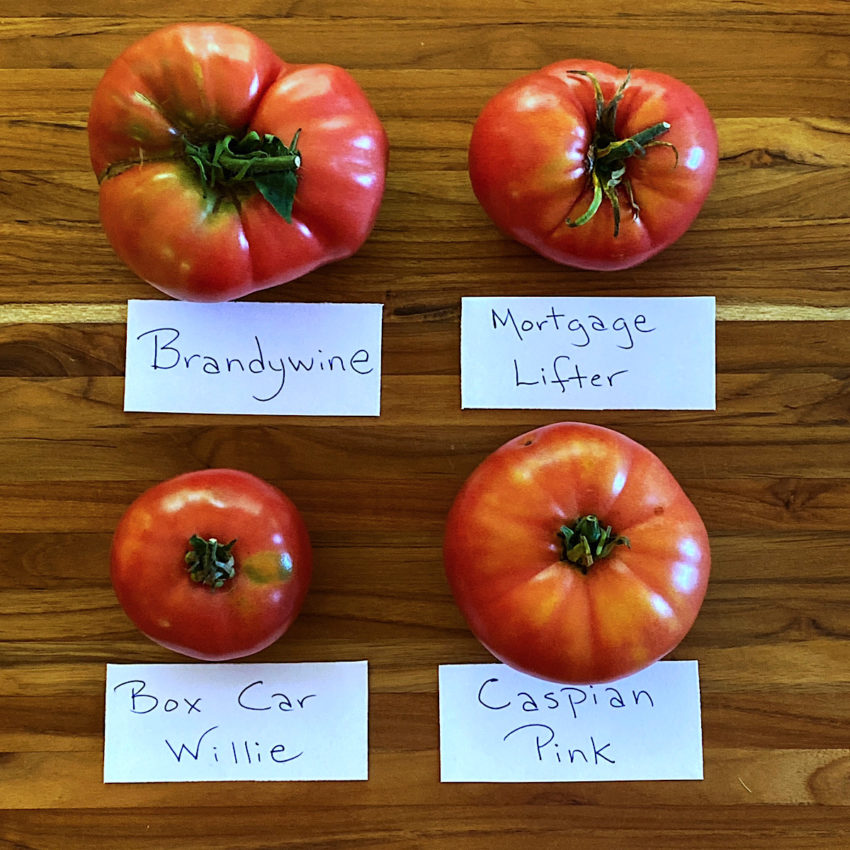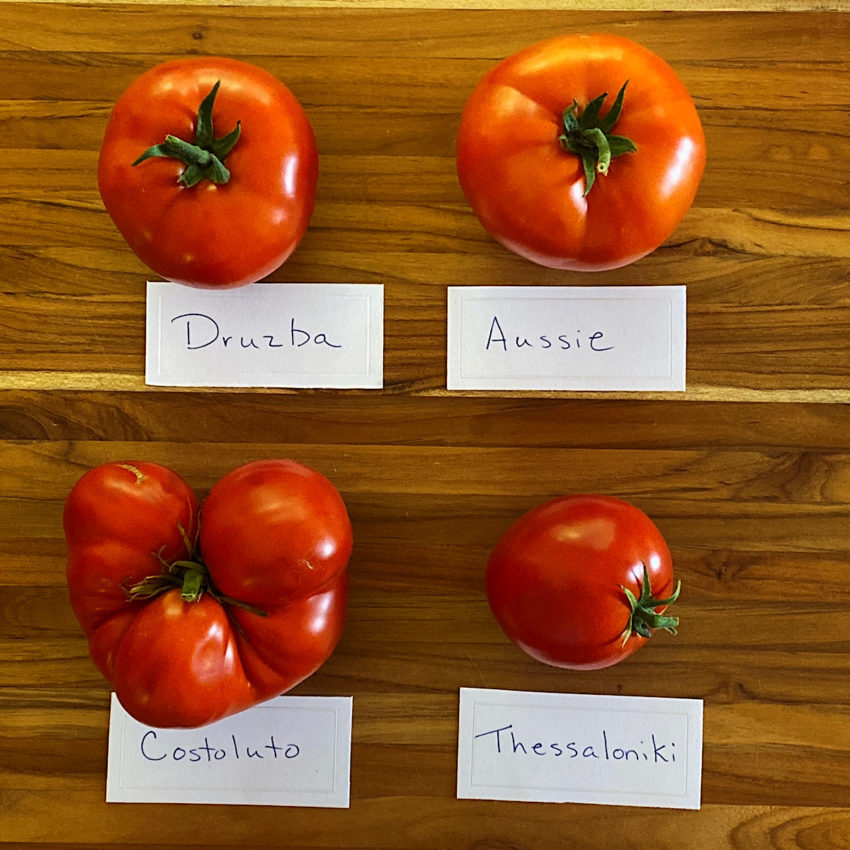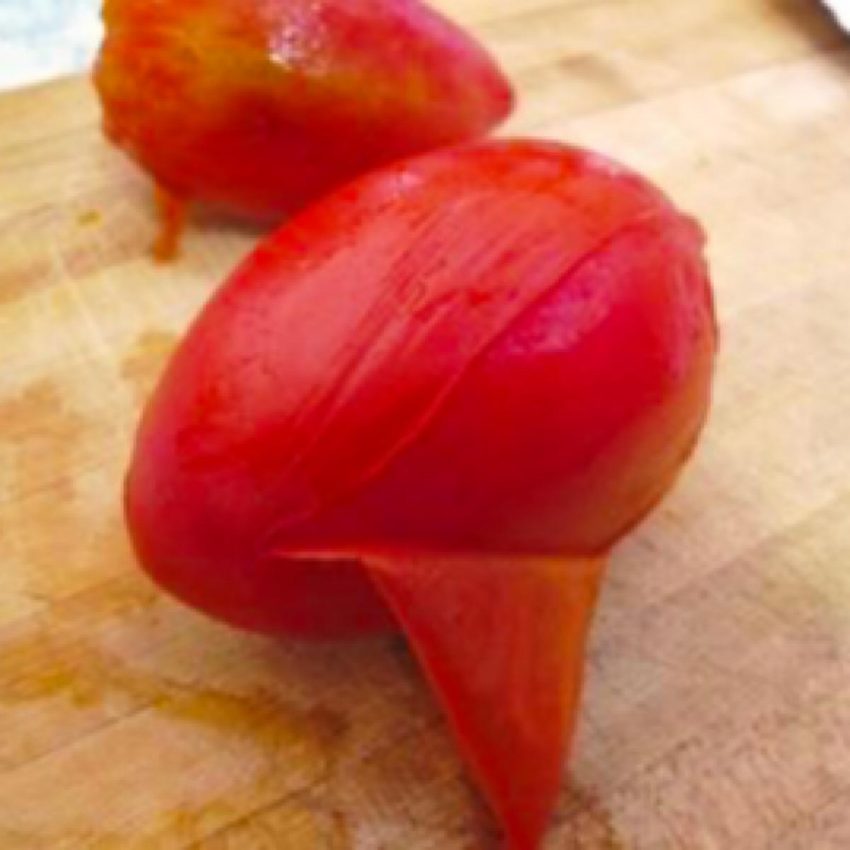This is a summary of the flavor, growth performance and unique qualities of what I consider to be the best heirloom tomato varieties in each color category. I have been growing, tasting and testing heirloom tomatoes since 1997 and this guide is based on that cumulative experience.

Jump to: Orange Varieties | Yellow | Black | Striped |Pink | Red | Roma types |Cherry types
This post may contain affiliate links. As an Amazon Associate, I also earn from qualifying purchases. You can read our disclosure information here–
What to Consider Before Buying Your Heirloom Tomatoes
Before opening those enticing seed catalogs with the beautiful photos, it is a good idea to take stock of which tomatoes performed well for you last year. This will help you make your selection based on the unique qualities of heirloom tomato varieties for your area.
This is a summary of the varieties I grow in zone 5, and how they fared for me over the years. I’ve arranged the summary according to color profiles, as I have found the flavor to be more similar within a particular color of heirloom tomato than across different colors (this is a generalization and there are exceptions).
My focus is on unique characteristics of the best heirloom tomatoes, focusing on flavor. I do however, address yield, earliness, disease resistance, etc. to the extent that I can in a summary blog post.
For a more complete summary of growing attributes, see Heirloom Tomato Summary Charts. For my favorite catalogs for ordering heirloom tomato seeds, see Top 5 Seed Catalogs for Heirloom Tomatoes.
I have also summarized detailed information on growth habits and performance of a wide range of heirloom tomatoes.
Orange Heirloom Tomato Varieties
In general, the orange heirloom tomatoes tend to be sweet (much sweeter than yellow low-acid tomatoes). They often have a slight tropical, spicy flavor. This sweet, fruity flavor is why Sun Gold cherry tomatoes are so popular. This photo shows my favorite orange tomatoes and yellow heirloom tomato varieties:

Orange Heirloom Tomatoes
Persimmon Orange – I have always grown Persimmon, primarily because I have a taste memory of a Persimmon grown in 1999 as the best tomato I had ever tasted. It has never lived up to that intense flavor in subsequent years, but it is always reliably good. Attributes include: large, relatively late season, meaty, sweet to very sweet, disease resistant, good yields for a large tomato. Always a staple orange tomato for me.
Kelloggs – I alternate between growing Kellogs and Nebraska Wedding varieties and cannot tell the difference between them in most years. Attributes: reliable, blemish free, main-season, sweet – but less intensely fruity than Persimmon, medium size, long season yields.
Juane Flammee – this one is beautiful (orange with a red interior). The flavor ranges from excellent & intense to good & sweet. I have bought this seed from different companies and sometimes that can make the difference in flavor, and sometimes it is a function of growing season nuances. It is small, but prolific, and always delivers on taste. It is prone to blossom end rot if grown in pots or given inconsistent watering.
Gold Medal – Over the years I have trialed many of the large, bi-colored tomatoes, including Pineapple, Big Rainbow, Hillbilly, and Old German. Gold Medal is similar to these other bi-colors in that it is
- beautiful,
- very sweet & flavorable,
- large and relatively late season.
It stood out from the other bi-colors in that it seemed less prone to cracking, and a higher yield.
Yellow Heirloom Tomatoes:
People generally think of yellow tomatoes as low-acid and mild, which many of them are. Some, however are quite tangy with a slight citrus flavor and are in no way mild. Hughs, Manyel and Great White lean toward the mild sweet side, with Limmony tending to be tangy with higher acid.

Hughs – I have grown this heirloom for several years now, due to the literature recommending it for its superior flavor. I will probably not grow this variety again, as I have found the plants to be fragile and susceptible to more disease, the flavor to be inconsistent, and the yield to be poor. I am sure some people love this tomato, but it has not fared well in the microclimate of our farm in Minnesota.
Limmony – This yellow heirloom always surprises people who are used to yellow tomatoes being low acid and mild. It is quite tangy with a zesty citrus flavor (hence the name), blemish-free, meaty, with high yields. It is a main-season tomato that will be a staple on our farm.
Manyel – I grew this one because it is a Native American heirloom (manyel means “many moons”), and because it is a reliable, small to medium, pale yellow, mild & juicy tomato. The yield is good and it is an early tomato. A keeper.
White Queen – Even though this heirloom is listed as a “white” tomato, it is actually pale yellow (see photo). This tomato manages to be mild without being bland. It has a sweet/fruity flavor and is considered a “palate refresher”. It is also early with relatively high yields.
Black Heirloom Tomatoes
“Black” tomatoes (many are actually purple) have become quite popular due to their rich, complex flavor. Most of the black tomatoes originated in Russia and they can range from large 1-2 lb. beefsteaks to small cherry tomatoes. They all share a very deep, somewhat sweet and wine-like flavor profile.

Paul Robeson – This is the second year I have grown Paul Robeson, and both years it has produced a medium sized, fairly early tomato with a superior flavor. The flavor is rich and somewhat smoky. Yields are good.
Carbon – I first tasted this heirloom from a Portland, Oregon farmers’ market and I was definitely wowed. Though somewhat smaller than the other blacks, the flavor was intense and the best I had tasted from the blacks so far. I had a little trouble locating seed and have not grown it long enough to vouch for its reliability, but it is definitely a keeper on taste alone.
Black from Tula – (mislabeled in photo as Black Russian) -This is the largest of the blacks, and the flavor is always good, but I continue to be disappointed in the yield and the lateness. This is probably the last year for this one.
Vorlon – Lynne Rosetto Kasper once called out this heirloom as one her top varieties for flavor (I try out all of our tomatoes with Lynne’s experienced Italian palate). In addition to excellent flavor, this tomato is blemish free and a good producer for us.
Black Heirloom Tomatoes (small)
Black Mauri – A new one for us in 2012, and we were delighted with it. Great taste, crunchy texture, prolific, blemish free…what more could you want? It’s small. Some consider it a grape tomato and some consider it a plum tomato. All consider it great.
Black Cherry – Consistently popular as a deeper-flavored cherry tomato. It is a bit larger than typical cherry tomatoes, and not as prolific, but the flavor is much more complex than the candy sweetness of the sweet 100 types.
Black Kirk – This is one of the earliest of the medium-sized black tomatoes for us. It is typically about 8 oz. and has a somewhat salty flavor in addition to the rich flavor profile of the blacks. Heavy producer.
Purple Russian – Another new heirloom for 2012 that we will definitely keep around. It is larger and lighter in color than Black Mauri, but has the full-flavor of the blacks. It’s great for salsas and salads, and has an egg shape. Also relatively early.
Another black heirloom that we grow and like, but do not have a photo of, is Japanese Black Trifele
Striped Heirloom Tomatoes:
Striped, or bi-colored, heirloom tomatoes are fun and add special eye-appeal to a tomato salad or a tomato tasting party. They range in flavor from mild & bland, to sweet & fruity, to high-acid and tangy. I do not have photos of all of the striped tomatoes we have grown and loved, but some memorable ones include: Mr. Stripey, Red Zebra, Dagma’s Perfection, Big Rainbow, Tigerella, and Marvel Stripe. Three of the most popular were:
Green Zebra – This is a staple for us, and once people get past the idea that it is “supposed” to be green, it often becomes their favorite. It is quite tangy and zesty in flavor with a fairly high acid level. You would think it would be fairly early due to its smaller size, but Green Zebra actually tends to be relatively late on our farm. Once it gets going it is prolific, but we are eagerly awaiting that first flush.

Gold Medal – This heirloom was summarized above under the orange tomatoes. It is actually a bi-color and beautiful.
Speckled Roman – The young plants looked quite spindly and I thought it might be a fragile plant, but once it got going it was strong and a good producer. The taste is somewhat mild, but the color and shape are fun to have on tomato platters.
Pink Heirloom Tomato Varieties:
There are many, many great pink varieties of heirloom tomatoes, the most well-known of which is Brandywine. Pink tomatoes tend to be sweeter and lower acid than the bright red heirlooms. Many think of the pinks as the tomatoes with that “old-fashioned flavor”.

I tend to prefer the bolder flavor of the red heirlooms, but the pinks can be very full-flavored at the right time of the year. Popular pinks which we have grown include: Caspian Pink, Cherokee Purple, Pruden’s Purple, Soldacki, German Pink, Wins All, Purple Calabash, and Rose De Berne.
I’m trying to winnow down the number of varieties I grow, so I usually only grow 5 or 6 varieties of pinks each year. Here are a few standards and a few new ones:
Mortgage Lifter – This is a reliable producer with a consistently sweet, full-flavored taste. Plus it has the great story of paying off “Radiator Charlie’s” mortgage by selling them for $1.00 a plant during the depression. It is earlier than Brandywine and I always grow it.
Brandywine – The first name that comes to the mind of people just starting in heirlooms is the Brandywine. It was one of the first varieties to regain status in popular culture for its “old-fashioned taste”. Since heirlooms have become popular, Brandywine has held onto its status, but for me it doesn’t taste much different from many of the other large pink heirlooms, and it has the disadvantage of being quite late and not very prolific. In Minnesota, it makes more sense to grow some of the other large pinks like Caspian Pink and Prudens Purple which are earlier, but people at the farmers’ market still want to buy the Brandywine, so I grow it.
Bali – This small, productive tomato was a powerhouse of flavor. I was quite surprised with the sweet, full flavor of Bali. It is pretty (ribbed), pink, sweet, and prolific. A keeper.
Red Heirloom Tomato Varieties:
People are often unaware that heirloom tomatoes can be red and smooth, looking very similar to hybrid tomatoes. The difference is in taste. The skin of red “heirloom” tomatoes will typically be thinner, as they have not been bred to travel long distances and maintain long shelf lives.

Flavor profiles of the red heirlooms vary, but most often they will have a bolder, higher acid flavor profile than the pink, black or orange heirlooms. Some of my favorite reds include:
Aussie – While not as full-flavored as some of the other reds, this one has a lot going for it. It is meaty, with few seeds, and one slice of this beefsteak will fill a BLT just fine.
Carmello & Dona – While some debate whether these two French varieties have been around long enough to be called heirlooms, no one debates the full balanced flavor of them. Carmello and Dona are the classic tomato you will find at French open-air markets and they are considered to have the perfect acid-sugar balance. Dona is the smaller version of Carmello. Seed is sometimes difficult to find.
Thessaloniki – A Greek heirloom with what is said to be an “earthy” taste. It is a favorite at the farmers’ market, both for its full tomato flavor and its highly productive nature. People count the number of tomatoes they get from these bushes and come back to tell me about it in amazement. It is also blemish free, which is nice.
Roma Heirloom Tomatoes
Many people go to the San Marzano for their choice of heirloom paste tomato. The problem is there seem to be many different “strains” within the seed companies of this variety, and you can never be sure what you are getting. In 2012, I grew the “Redorta” strain, and it was good, but most seed companies do not tell you what strain they are producing.
Taste can vary widely and the typical Roma doesn’t have much taste to begin with. The following three are the paste tomatoes I have ended up with after many trials, with Opalka being the flavor winner for me.

Amish Paste – This heirloom is full-flavored, but it is not really a “paste” tomato. It is much juicier than a typical paste, and can be used as a slicer in most cases. The size and yield is also quite variable, ranging from medium size to quite large, and medium yield to very low yield.
San Marzano – As noted above, this heirloom is inconsistent in flavor, depending on which strain you get. Yields are typically good, but the tomato meat can be quite dry at times.
Opalka – My favorite of the paste tomatoes. It has everything you’d want in a paste: full flavor, meaty texture, high yields, large size. It tends to look a bit clumsy and can be oddly shaped. If that matters to you.
Cherry Tomatoes (Heirloom and Hybrid)
Typically the cherry tomatoes share these attributes: a) they are sweet, b) they are prolific yielders, c) they grow well in pots even though they are indeterminate, and d) they tend to crack, e) they are usually hybrids although there are some heirlooms. Here are a few of my favorites:

Matts Wild Cherry – An heirloom, tons of tiny sweet cherry tomatoes will fill your plant all season. I only grow a few of these, as I don’t like to pick that many small tomatoes for market
Principe Borghese – An Italian heirloom that I have always grown and always will. It has a full, meaty tomato flavor rather than the sweeter cherry tomato flavor, and it is the absolute best for drying. Just cut them in half and dry. I grow a lot of these and sell the dried tomatoes at market in the winter. They are also nice for salads.
Tomatoberry – Jury is still out on this one. The seed was expensive and there is a high demand for this hybrid cherry, most likely because it is crack free and easy to grow. The taste was different however, with a lot of varying opinions. I’ll have to try this again, but I wasn’t impressed with the flavor this year.
Black Cherry – The same rich flavor profile of the larger blacks in a cherry. Not as prolific as most cherries and a little larger.
Black Mauri – Considered a grape tomato, and was a new variety for us this year. I loved the full, sweet flavor and it was a blemish-free, high-yielder. A keeper.


I enjoyed this site and your many recommendations.
However, I cannot understand why you do not list Cherokee Purple. I am growing 20 CP plantsfor myself and friends. It receives more excellent reviews than any other heirloom tomato to my knowledge. Please check it out and indeed try it if you have not done so before Cordially, John Steinmeyer
Hi John, I do grow Cherokee Purple. I just didn’t grow it last year and these photos are of 2012 tomatoes. It is a good tomato and does get good reviews, but so do a lot of other similar types. I grow Cherokee Purple every other year and will be growing it again this year. People at my markets like it, but I get better reviews for some of the other similar heirlooms, so I don’t grow it every year.
I haven’t found a Cherokee Purple that I like. Or a Black Krim, for that matter. For some reason, it’s the TEXTURE of the tomato that makes or breaks it. I hate slimers, and the other end of the spectrum, the gritty types that seem to be so prevalent.
The ones I tasted weren’t refrigerated, they slipped off the vine and I couldn’t eat them after the first bite. We waited for a few more to ripen but then yanked the full grown plants because I didn’t consider them edible and didn’t want them to cross-pollinate with the Silvery Fir Tree or the Flamingo that was so much better.
Interesting Gloria. Do you like any of the other black or purple tomatoes? The favorites at my market are Carbon and Paul Robeson. There is a purple russian and black mauri that people like a lot, but they are plum and grape tomatoes. The Black Mauri is said to have a “crisp” taste so you might like that one better.
Was researching tomatoes for next year and found your article…
I usually do 25 different heirloom varieties for past 3 years (mostly black tomatoes)… Here are my favs:
I really like the small/medium black tomatoes that are prolific and dont’ crack/blemish… Last year i grow Black Ethiopian and this year added Nyagous … Nyagous is a great one as it hardly cracks while Black Ethiopian always cracks on top so will replace B.E. with Nyagous next year.
Japanese Black Trifle is a great one… cool shape. prolific. never cracks. prone to hard/unripe/green shoulders on top though.
^Those 2 I think are my favs right now…
Green Zebra/Black Zebra: prolific and more acid flavor that some family members like. Black Zebra was less acidic, sweeter/saltier like a black tomato, and larger (but less prolific).
Chocolate Stripes: early large tomatoes and lasted late into season. pretty tomato.
Paul Robeson, Black Tula: both are staples for blacks so growing again. prone to crack for me sometimes though. Might replace in future at some point. Ive tried alot of blacks but its hard to settle on the best ones like Carbon, etc when limited by space.
Cherokee Chocolate: flavorful, large.
Brad’s Blackheart: larger black tomatoes. outside color is a bit ugly though for me sometimes (gray-ish green vs that ‘black’ color). kinda an oxheart shape.
Golden King of Siberia: large oxhearts… birds seem to poke more at my yellow tomatoes though, so might grow other oxhearts instead.
Anna’s Russian: prolific oxhearts.
Going to try Sarah Black, Vernissage, and Black Sean Man next year.
Arian, Thank you so much for sharing your tomato findings! I especially find helpful your comments on which ones crack. I tried Nyagous before and liked it, may have to bring that one back. The other black small one I like is Black Mauri, and this was my first year with Chocolate Stripes which is getting rave reviews at market so far. Interesting that the birds peck at your yellow tomatoes…I have noticed that also, but thought I was imagining it.
Hi, I think that I have a tomatoe from Heaven-really. I would give up everything in my garden just to keep this one. It is small-no longer than the end of your smallest finger and so sweet taste no one believes it! Indeterminate, no end rot, prolific, grows until the frost! And a very determined tomatoe-I accidently put it together in the ground with an Ukrainian Ox Heart, and it still grew! Like move over buddy! I have looked everywhere to find out about it but have not found it anywhere…Plus, this year a garden-neighbor gave me four tomatoe plants which grew to be black-blue-purple–Indeterminate, VERY prolific (about 100 tomatoes per plant), sturdy stems, dark green and dark blue leaves, but took 3 months to ripen. The final tomatoe is still purple on top and has an amber color on the bottom; the taste is interesting-it has a little pepper bite at the end. What is this tomatoe?? Allie
Allie,Whats the name of your heaven little tomato?
pappabell
Hi Allie, You don’t say what color the small cherry tomato is? As far as the blue-purple-black tomato, there are quite a few heirlooms that fit your description. It would help to know the size and shape of the tomato itself (not the plant). Based on your description it could be Japanese Black Trifele, Carbon, Paul Robeson, Purple Russian, Black Maurie, etc. Shape, size and color of the tomato are neede (a photo would be best). Also, google “black heirloom tomatoes” and look at the photos that are posted to help you out.
[…] Go to a garden center and indulge. Buy some special herbs. Or some heirloom tomato plants. Then plant and watch them […]
Thank you for sharing….very helpful.
Allie,Whats the name of your heaven little tomato?
pappabell
Over in Sweden, I have been very happy with Korol Gigantov (Russian for “Giant King”). Truly giant red beef tomatoes, prolific producer and can handle colder climes. I agree that Black from Tuula is not as prolific. Barred boar is a green and red striper and quite sour and was my easiest to grow (thick, hardy stems). Bosque blue was a disappointment…not so prolific, not so blue. The best plants over the years for me have been the ones that I grew from the few seeds I collected when I ate a good tomato. If I bite into something nice, I always try and save some seeds from it in a napkin. I look forward to trying persimmon orange and paul robeson next season, thanks for the tips!
Thank you for the great comments on some varieties I haven’t yet grown. Saving seeds is an excellent way to make sure you get your favorites going. I haven’t yet gotten into seed saving….seems I’m always too busy so I let the seed companies do it for me. It’s better when you save seeds because you know which ones grew best in your microclimate!